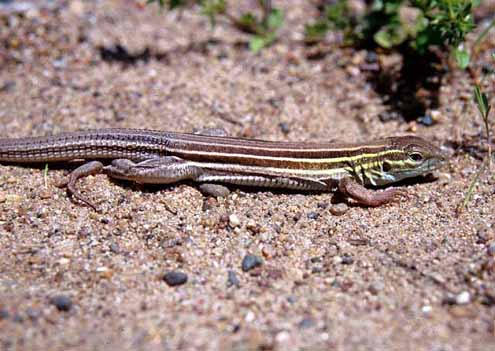Lizards must be tasty. There’s not many snake, mammal or avian predators here in Cross Timbers Country that will pass up the opportunity to catch and eat one. Maybe we’re missing out on something. A few eons back, lizards and their ken were the dominant predators and atop the food chain. Today, a lizard is more likely to be what’s for dinner.
Most species of lizards have adapted to living with bigger critters that like to eat them by using their camouflage coloration to hide or blend in with their surroundings. By remaining motionless, they sometimes elude predators that are always on the lookout for their movement. Others climb trees, dive into holes or crawl into crevices to escape the jaws of death. Being fleet afoot can be the difference between getting a meal and being one. There are a couple of speedster lizard species found here in Cross Timbers Country that will give most predators a run for their money.
It was great sport when I was a kid to catch a racerunner, put it in a little wire cage and feed it grasshoppers. Trouble was, catching one wasn’t all that easy. They were quicker than greased lightning. My cousin and I finally figured out the best way to catch one was to pop it with a big old rubber band to knock it off its feet and then scoop it up before it knew what happened. Sometimes all we’d wind up with was a wiggling tail and no lizard.

Of the eleven species of whiptail and racerunner lizards of the Family Teiidae found in Texas, only the prairie-lined racerunner (a six-lined racerunner subspecies) and the Texas spotted whiptail call Cross Timbers Country home. Most other species in this group live in arid regions of West and Southwest Texas.
The prairie-lined racerunner subspecies Cnemidophorus sexlineatus viridis ranges throughout the central part of Texas from the Rio Grande northward and up to southern South Dakota. They live in a wide variety of habitats including sandy fields, banks and floodplains of rivers, open grassy areas and rocky outcrops. This racerunner is six to ten and one-half inches from snout to tip of tail. Its tail is two and one-third times the length of their head and body. Six yellow lines extend from just behind their eyes down the side of their body. A pale dorsal stripe goes all the way down their tail. Overall dorsal and later coloration of breeding males is bright green except for the brown tail. Underneath, their belly is pale blue. Females may be a little larger than males and have white bellies. Both sexes have eight rows of large, smooth rectangular scales on their belly.
Prairie-lined racerunners mate from April to June and lay one to six eggs in a burrow. A second clutch is laid three weeks later and eggs hatch on their own in 48 days from June to September. Young measure two and three-quarters inches including their slender blue tail.
The Texas spotted whiptail subspecies C. gularis gularis is widely distributed in Texas except in far East Texas, the northern Panhandle and parts of the Trans-Pecos. Semiarid prairies, dry canyon bottoms, heavily pebbled expanses of sandy soil with sparse vegetation, rocky hillsides near floodplains and rocky washes are the preferred habitat. Texas spotted whiptails average seven to nine and one-half inches but some males may reach 12 inches. Their tail measures about twice the length of the head and body. Females are slightly smaller than males. They have seven or eight pale green, white or yellow vertebral stripes (the dorsal strip may or may not be split). Overall coloration varies from warm to dark brown. Yellowish or white spots adorn their sides and the tail is pinkish or orange-brown. Males have a reddish throat with some black or dark blue on their chest. Their belly is uniformly dark blue. The female’s throat is pale pink and belly white. This species is not as wary as other whiptails.
Texas spotted whiptails mate in April and May and lay one to five eggs from May to June. A second clutch may be laid in late July. Young are about four inches long with bright light stripes and faint spotting on their sides. Their tail is pink or reddish.
Racerunners and whiptails move about with short burst of speed and seldom stay still for very long. Their nervous disposition keeps them active, particularly during the hottest part of the day. Try to catch one and they’ll stay just out of reach. It’s been estimated that they can run in burst at 18 mph. Their extremely long tail provides balance while running, and if it becomes detached, it will regrow but be shorter than the original.
Being terrestrial, these lizards forage and scratch through leaf litter or loose soil for food items. They also use their pointed snout to probe loose soil and debris to sniff out their victims. Grasshoppers, crickets, ants, flies, termites, snails, caterpillars, spiders and other arthropods make up the bulk of their diet. Spotted whiptails may eat leave and blossoms of flowering plants.

To whiptails and racerunners, winning the race is everything. Those that come in second may be lunch with a crunch. Until next time, I’ll see you down the road and God Bless America!